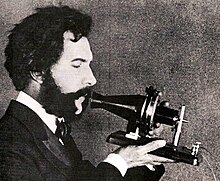The first telephone was invented by Alexander Graham Bell which started off as a harmonic telegraph. This is a device that allows multiple messages to be transmitted at the same time over a wire. This led Bell to become preoccupied with trying to find a way to transmit human voices over wires. However, in 1875 with the help of Thomas Watson, they came up with a simple receiver that was able to turn electricity into sound. Many other scientists were working on very similar technologies which causes some debate as to who should really be credited with the invention of the telephone. Scientists like Antonio Meucci and Elisha Gray are some examples that could have created the telephone first and not Alexander Graham Bell. The first-ever telephone call was Bell saying to Watson, “Mr. Watson, come here. I want you”. This happened in 1876 and by 1877 the Bell Telephone Company was created, later known as AT&T. About thirty years later in 1915, the first transcontinental phone call was made from New York to San Francisco.
Today the telephone brings us instantaneous communication, as opposed to writing and delivering messages by hand. This method of communication allowed for governments to steer the course of battle and war. It eliminated the delay of previous communication to positively affect the government, journalism, business and exc. One major impact is the use of emergency response time. By being able to call 911 the telephone greatly reduced the response time of emergency responders as well as the increase in the number of reported emergencies. The telephone also led to economic growth and increased profits. Quick communication improved the ways business could deliver its goods to fill customer orders. This also gave farmers a way to see the most current price for their crops. Mobile communication allows anyone to work from any location at any time. This decreases the worker’s time to commute by allowing them to work from home or help the company save money by not renting office space.
To me, the invention of the telephone is one of the most commonly used inventions today. Every day we send messages to others just from our phones. Although this started with just talking on the phone, it eventually improved to be able to send messages as well. The telephone is something that we don’t really appreciate everyday but simply take it for granted that we can communicate through a device to someone that is across the world in another country.
